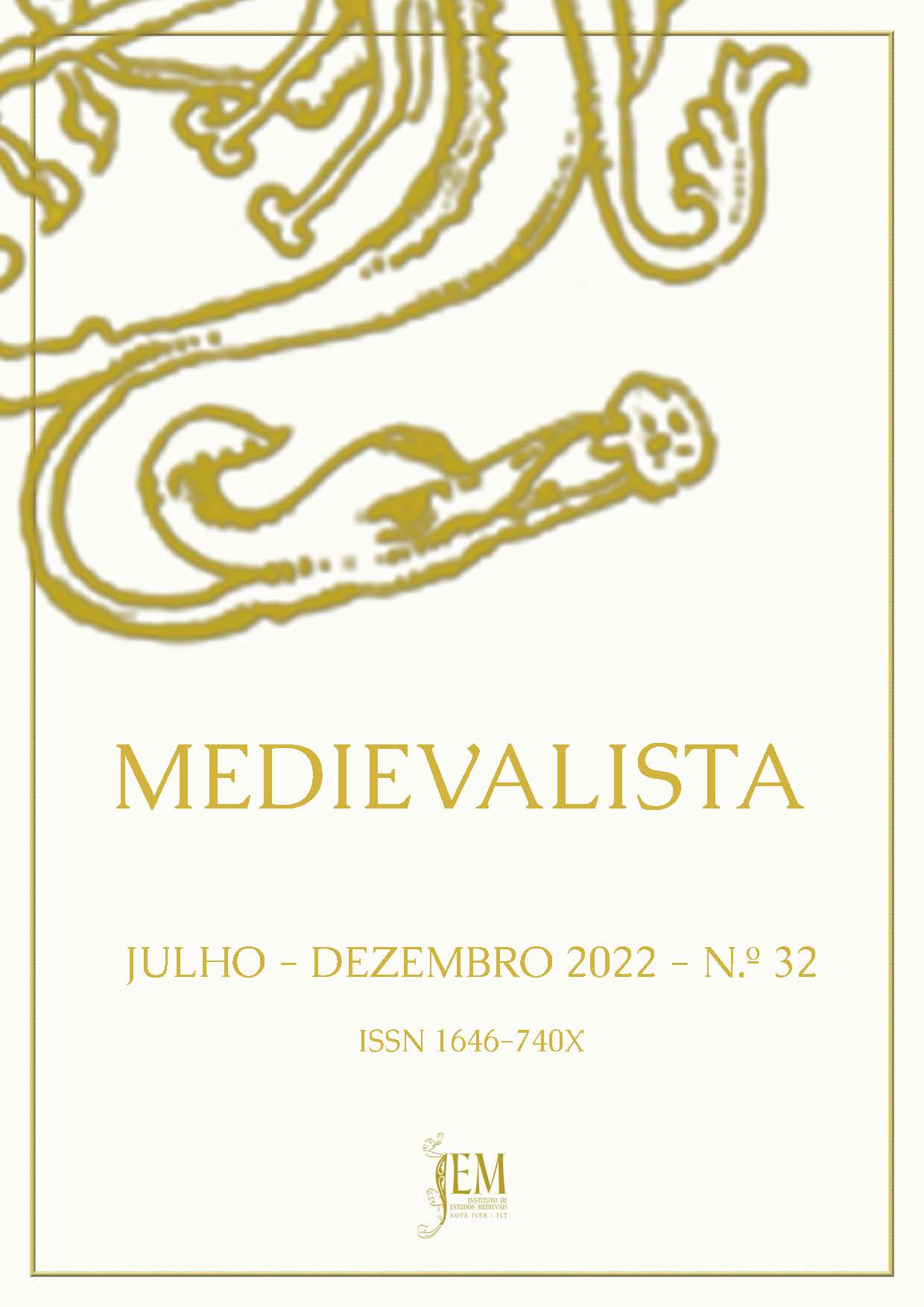Arthur ainda vive? O problema da crença em seu retorno no século XII
DOI:
https://doi.org/10.4000/medievalista.5648Palabras clave:
Messianismo Régio, Rei Arthur, Escrita histórica, História vista de baixoResumen
Há uma tradição historiográfica que associa a figura do Rei Arthur com o messianismo régio, expresso pela esperança de alguns grupos étnicos insulares que carregaram em comum um substrato de traços culturais celtas (córnicos, bretões e galeses) em seu retorno. Essa esperança, conhecida na historiografia como “espera bretã”1, foi apontada em algumas fontes dos séculos XII e XIII, nas quais os cronistas assinalavam que Arthur não estaria, de fato, morto para alguns grupos étnicos dentro do território da Grã-Bretanha.
Desde a década de 1990, a discussão sobre a tese da espera bretã se transformou. Virginie Greene questiona a pertinência de utilizar o termo “messianismo” para referir-se à realidade medieval e argumenta que ele não se aplica com o mesmo sentido que os historiadores utilizam para se referir à modernidade2.
Neste ensaio, tentamos retirar a análise do escopo de sua reprodução dentro do espaço cortês através da análise de crônicas selecionadas, partindo da perspectiva do movimento historiográfico conhecido como “A História Vista de Baixo”, para depreender quem é o povo que espera por Arthur e se essa espera é mais do que um discurso construído pelos cronistas.
A partir de um cruzamento entre crônicas e estudos arqueológicos, tentamos mapear tradições de culto, peregrinação e folclore associadas a Arthur, circulando pela Grã-Bretanha dominada pelos normandos. Executamos uma leitura das fontes observando referências laterais a Arthur e prestando atenção nas relações de poder que as crônicas ensejam.
1. - TATLOCK, J.S.P. – “Geoffrey and King Arthur in Normannicus Draco”. Modern Philology XXXI/2 (November 1933), pp. 1-18.
2. - GREENE, Virginie – “Qui croit au retour d’Arthur?”. Cahiers de Civilisation Médiévale 180 (Octobre- Novembre 2002), p. 335.
Referências bibliográficas
Fontes
Fontes impressas
GALES, Geraldo de – Instructions for a ruler: De principis instructione. Editado por Robert Bartlett. Oxford: Oxford Scholarly Editions Online, 2018.
GALES, Geraldo de – Liber de principis instructione [Em linha]. Traduzido por John William Sutton. Rochester: 2001. [Consultado a julho 2020]. Disponível em https://d.lib.rochester.edu/camelot/text/gerald-of-wales-arthurs-tomb.
MONMOUTH, Geoffrey de – Historia regum Britanniae. Editado por Michael D. Reeve, traduzido por Neil Wright. Woodbridge: Boydell Press, 2007.
TOURNAI, Herman de – Miracula Sancte Marie Laudunensis. Editado por Alain Saint Denis. Paris: Éditions du CNRS, 2008.
Estudos
ARNOLD, John – “The historian and the inquisitor: the ethics of interrogating subaltern voices”. The Journal of Theory and Practice 2 (1998), pp. 379-386.
ARNOLD, John – “Religion and popular rebellion from the Capuciati to Niklashausen”. The Journal of Social History Society 6 (2009), pp. 149-169.
ARNOLD, John – “History from below - some medievalist perspectives”. The many- headed monster. [Em linha] [Consultado a julho 2020]. Disponível em https://manyheadedmonster.wordpress.com/2013/08/20/john-arnold-history- from-below-some-medievalist-perspectives/.
BENJAMIN, Walter – “Teses sobre o conceito de História”. In Obras escolhidas. Vol. 1. Magia e técnica, arte e política. Ensaios sobre literatura e história da cultura. São Paulo: Brasiliense, 1987, pp. 222-232.
BAKHTIN, Mikhail – “O problema do texto”. In Estética da criação verbal. São Paulo: Martins Fontes, 1992, pp. 327-359.
BAKHTIN, Mikhail – A cultura popular na Idade Média e no Renascimento: O contexto de François Rabelais. São Paulo: Hucitec, 2010.
BARBER, Richard – King Arthur: Hero and legend. Nova Iorque: St. Martin Press, 1986.
BARCZEWSKI, Stephanie – Myth and national identity in nineteenth-century Britain: The legends of King Arthur and Robin Hood. Oxford: Oxford University Press, 2000.
BENJAMIN, Walter – “Teses sobre o conceito de História”. In Obras escolhidas. Vol. 1. Magia e técnica, arte e política. Ensaios sobre literatura e história da cultura. São Paulo: Brasiliense, 1987, pp. 222-232.
BERARD, Christopher Michael – “King Arthur and the canons of Laon”. Arthuriana, 26/3 (2016), pp. 91-119.
BERARD, Christopher Michael – Arthurianism in early plantagenet England. From Henry II to Edward I. Woodbridge: Boydell & Brewer, 2019.
BLICK, Sarah – “Common ground: Reliquaries and the lower classes in late medieval Europe”. In ROBINSON, James; DE BEER, Lloyd; HARNDEN, Anna (org.) – Matter of faith: An interdisciplinary study of relics and relic veneration in the medieval period. Londres: The British Museum, 2014, pp. 110-116.
BREEZE, Andrew – “Arthurian early saints’ lives”. In ECHARD, Siân (ed.) – The Arthur of medieval Latin literature. The development and dissemination of the Arthurian legend in medieval Latin. Cardiff: University of Wales Press, 2011, pp. 26-45.
CASSARD, Jean-Christophe – “Arthur est vivant! Jalons pour une enquête sur le messianisme royal au moyen âge”. Cahiers de civilisation médiévale 126 (Avril - Juin 1989), pp. 135-146.
CHIBNALL, Marjorie – “Ecclesiastical patronage and the growth of feudal estates at the time of the Norman conquest”. Annales de Normandie 2 (1958), pp. 103-118.
CRICK, Julia – “The British past and the Welsh future: Gerald of Wales, Geoffrey of Monmouth and Arthur of Britain”. Revista Celtica 23 (1998), pp. 60-75.
DILLON, Anne – “John Forest and Derfel Gadarn: A double execution”. Recusant History 28 (2006), pp. 1-21.
DOBLE, G. H. – “The reliques of St. Petroc”. Antiquity 13/52 (December 1939), pp. 403-415.
ECHARD, Siân – “Geoffrey of Monmouth”. In ECHARD, Siân (org.) – The development and dissemination of the Arthurian Legend in medieval latin. Cardiff: University of Wales Press, 2011, pp. 51-52.
FALETRA, Michael – Wales and the medieval colonial imagination: The matters of Britain in the twelfth century. Manchester: Palgrave Macmillan, 2014.
GEARY, Patrick J. – “Peasant religion in medieval Europe”. Cahiers d'Extrême Asie 12 (2001), pp. 158-209.
GINZBURG, Carlo – O Queijo e os Vermes: O cotidiano e as ideias de um moleiro perseguido pela Inquisição. São Paulo: Companhia de Bolso, 2006.
GRANSDEN, Antonia – “The growth of the Glastonbury traditions and legends in the twelfth Century”. Journal of Ecclesiastical History 27/4 (1976), pp. 337-358.
GREENE, Virginie – “Qui croit au retour d’Arthur?”. Cahiers de Civilisation Médiévale 180 (Octobre - Novembre 2002), pp. 321-340.
HARVEY, Sally P. J. – “Domesday book and anglo-norman governance”. Transactions of the Royal Historical Society 25 (1975), pp. 175-193.
HENLEY, Georgia – “Geoffrey of Monmouth and the conventions of history writing in early 12th century England”. In HENLEY, Georgia; SMITH, Joshua Byron (org.) – A companion to Geoffrey of Monmouth, Leyde: Brill, 2020, pp. 291-314.
HITCHCOCK, David – “Why History from below matters?” The many-headed monster [Em linha] (2013) [Consultado a 20 julho 2020]. Disponível em https://manyheadedmonster.wordpress.com/2013/07/22/david-hitchcock-why- history-from-below-matters-more-than-ever/.
HURLOCK, Kathryn – Medieval pilgrimage in Wales. Manchester: Palgrave Macmillan, 2018.
JONES, Aled Lion – Darogan, prophecy, lament and absent Heroes in medieval Welsh literature. Cardiff: University of Wales Press, 2013.
JÚNIOR, Hilário Franco – Os três dedos de Adão: Ensaios de mitologia medieval. São Paulo: Edusp, 2009.
KAY, Morgan – “Prophecy in Welsh mnuscripts”. Proceedings of the Harvard Celtic Colloquium 26/27 (2006/207), pp. 73-108.
LE GOFF, Jacques; NORA, Pierre – História: novos objetos. Rio de Janeiro: Francisco Alves, 1988.
LE ROY LADURIE, Emmanuel – Montaillou, povoado occitânico de 1294 a 1324. São Paulo: Companhia das Letras, 1997.
LOOMIS, Roger Sherman (org.) – Arthurian literature in the middle ages: a collaborative history. Oxford: Clarendon Press, 1959.
LUPACK, Alan – The Oxford guide to Arthurian literature and legend. Oxford: Oxford University Press, 2007.
MENJOT, Denis – “Les gens venus d’ailleurs dans les villes médiévales: quelques acquis de la recherche”. In MENJOT, Denis (org.) – Arriver en ville – les migrants en milieu urbain au Moyen Âge. Paris: Éditions de la Sorbonne, 2013, pp. 15-29.
PADEL, O. J. – “The nature of Arthur”. Cambrian Medieval Celtic Studies 27 (1994), pp. 1-31.
PEREIRA, Rosuel Lima – “Heroísmo, guerra e imaginário: Raízes medievais e socioculturais do Sebastianismo maranhense”. In História antiga e medieval. Conflitos sociais, guerras e relações de gênero: representações e violência. Vol. 6. São Luís do Maranhão: Editora UEMA, 2017, pp. 365-374.
ROBERTS, Brynley F. – “Cullhwch ac Olwen, the triads, Saints lives”. In BROMWICH, Rachel; OWEN, Alfred; JARMAN, Hughes; ROBERTS, Byrnley F. (eds.) – The Arthur of the Welsh: The Arthurian legend in medieval Welsh literature. Cardiff: University of Wales Press, 2013, pp. 73-97.
SCOTT, James C. – Weapons of the weak: Everyday forms of peasant resistance. New Haven: Yale University Press, 1987.
SILVA, Patrícia Antunes Serieiro – Polêmica anti-herética e repressão: perseguição e vindicta contra hereges na Summa Adversus Catharos et Valdenses de Frei Moneta de Cremona, OP. São Paulo: Universidade de São Paulo, 2019. Tese de Doutoramento.
SIMS-WILLIAMS, Patrick – “Did itinerant Breton conteurs transmit the matière de Bretagne?” Romania 116, 461-462 (1998), pp. 72-111.
SIMS-WILLIAMS, Patrick – “The early Welsh Arthurian poems”. In BROMWICH, Rachel; OWEN, Alfred; JARMAN, Hughes; ROBERTS, Byrnley F. (eds.) – The Arthur of the Welsh: The Arthurian legend in medieval Welsh literature. Cardiff: University of Wales Press, 2013, pp. 33-73.
ST. Petroc’s Church. Cornwall guide [Em linha] [Consultado a julho 2020]. Disponível em https://www.cornwalls.co.uk/bodmin/petrocs_church.htm.
SULLIVAN, Karen – The danger of romance – Truth, fantasy and Arthurian fictions. Chicago: The University of Chicago Press.
TAHKOKALLIO, Jaakko – “Fables of King Arthur”. Mirator 9/1 (2008), pp. 19-35.
TATLOCK, J.S.P. – “Geoffrey and King Arthur in Nomannicus Draco”. Modern Philology XXXI/2 (November 1933), pp 1-18.
TATLOCK, J.S.P. – “The English journey of the Laon canons”. Speculum 8/4 (1933), pp. 454-465.
TOLHURST, Fiona – Geoffrey of Monmouth and the translation of female kingship. Londres: Palgrave Mcmillan, 2013.
VEYSSEYRE, Géraldine; WILLE, Clara – “Les commentaires latins et français aux Prophetie Merlini de Geoffroy de Monmouth (XIIe -XVe siècle)”. Médiévales [Em linha] 55, outono de 2008 [Consultado a julho de 2020]. Disponível em http://journals.openedition.org/medievales/5513.
WEST, Francis James – “The colonial history of the Norman conquest?”. History 84/274 (1999), pp. 219-236.
ZUMTHOR, Paul – A letra e a voz. São Paulo: Companhia das Letras, 1998.



















